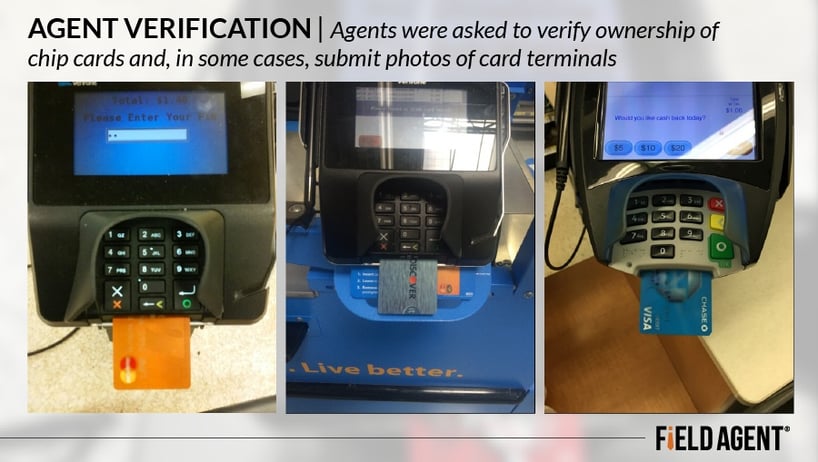
Pain or Gain? New EMV Chip Cards & the Shopper's Experience
![]() Most of us like new things.
Most of us like new things.
Some of us like shopping for new things.
None of us likes paying for new things.
Which makes in-store checkout kind of a drag.
As Paco Underhill, author of Why We Buy, once penned:
“…the register is the least pleasing part of the store…In fact, all that is experienced is loss (of money) and PAIN (of waiting in line, of waiting for credit card approval…).” (emphasis added)
Over these past many months, stores far and wide have invested considerable capital upgrading their credit and debit card systems to accept EMV cards (i.e., chip cards)—all in an effort to reduce the likelihood of fraudulent purchases and, of course, avoid any related liability.
EMV Card Processing: Pain or Gain for Shoppers?
But is the new EMV system reducing the pain shoppers associate with checkout…or adding to it? That is, how has chip card processing affected the shopper experience?
Last week, Field Agent conducted a location-specific audit of 100 EMV processing systems across the top eight retail chains, as ranked by the National Retail Federation. We also ran a survey of 300 chip card users.
Together, the audit and survey helped us appreciate the shopper’s experience with the new—occasionally troubled—EMV processing system.
Below are 5 important insights from this project.
Want even more insight? Sign up for our new Field Notes newsletter, and you’ll receive an exclusive chip card insight in the May edition.
1. On average it took shoppers 16 seconds to run their chip cards
We sent 100 verified chip card owners to 8 retail chains to make a purchase using their cards. We sent at least 10 Agents to each chain. Using the stopwatch feature in the Field Agent app, Agents timed how long it took to complete their purchases with chip technology.
On average, it took 16.1 seconds.

As the table below displays, we also broke down results by retailer.
However, caution should be exercised in drawing comparisons among retailers. Sample sizes were too small, and shopper behavior too varied (e.g., different mixes of credit and debit purchases), to justify cross-retailer comparisons.
![Time To Process EMV Card (in seconds) [CHART] Time To Process EMV Card (in seconds) [CHART]](//blog.fieldagent.net/hs-fs/hubfs/Campaigns/Chip_Card/Chip-Card-time-chart.jpg?width=350&name=Chip-Card-time-chart.jpg) 2. 43% of EMV auditors said it took less time than expected to run their chip cards, compared to 23% who said it took longer
2. 43% of EMV auditors said it took less time than expected to run their chip cards, compared to 23% who said it took longer
Rather than focus on retailers’ objective performances, our study primarily set out to understand shoppers’ subjective experiences with EMV card processing.
Some of our questions focused on the perception of time and speed—how long, in shoppers’ minds, it takes to use a chip card.
Of the EMV auditors who answered the question (n = 85), 43% said they felt it took less time than expected to use their chip cards, while 23% said it took longer.
We took a more general approach for the survey of 300. Field Agent asked, “In general (i.e., based on all your experiences), how slow or fast has chip card payment been?”
Shoppers were evenly split, with 41% saying the system has generally worked fast for them and the same percentage saying it’s generally run slow.
And what happens when shoppers compare the speed of the new chip card system with the former swipe-and-sign system? Something interesting happens.
Fully 63% of respondents said they’ve found it slower to process a chip card, when compared to swiping a card.
![In your experiences, how familiar are cashiers with the chip card payment processing system? [CHART] In your experiences, how familiar are cashiers with the chip card payment processing system? [CHART]](//blog.fieldagent.net/hs-fs/hubfs/Campaigns/Chip_Card/Chip-Card-cashier-piechart.jpg?width=350&name=Chip-Card-cashier-piechart.jpg) 3. Almost 90% of shoppers feel checkout personnel are at least moderately familiar with EMV processing
3. Almost 90% of shoppers feel checkout personnel are at least moderately familiar with EMV processing
If shoppers are unsure how to process their new chip cards, we reasoned, they’ll likely ask cashiers for help. But this begs the question: Have they found these employees knowledgeable of the system?
As you can see in the chart, 54% of chip card users reported that, based on all their experiences, cashiers have been either extremely or very familiar with how to process chip cards. Perhaps more importantly, absolutely no one in the survey responded “not at all familiar.”
See also: The Click-and-Collect Craze: 6 Shopper Insights into the BOPUS Trend
4. At this point, 63% of EMV card users in our survey would rather swipe a card than insert a chip card
One of the more important questions of the survey.
We wondered, at this point, do shoppers prefer the chip card to the conventional swipe-and-sign system?
No. In fact, of the 300 surveyed, only 37% reported a preference for EMV cards over the swiping variety.
But why? A question that leads to the final insight…
5. Top frustrations include uneven adoption among retailers and slow processing speeds, among others
We gave all 300 participants a chance to air their frustrations with EMV payment processing, and, clearly, many shoppers had chips not only in their wallets but on their shoulders as well.
The most common frustrations included uneven adoption among retailers (i.e., some have/use the technology, others don’t) and what many shoppers perceive to be slower processing times, compared to the swipe-and-sign system:
Male, 54, Duluth, GA: It just takes too long! Then other customers don't know how to use it and that delays things further
Female, 58, Merrillville, IN: So far it has added confusion to the check out process since some readers work and some don't. I have not seen the advantage to using them.
Female, 44, Sylvania, OH: It takes forever for it to process. It is really frustrating if you are in a hurry.
Female, 53, Nashville, TN: It is much slower than swiping the card process. And I hate the annoying sound the point of service device makes when the card is ready to be removed.
Male, 57, Franklin, TN: Most of the machines don’t work yet so it takes longer because I don’t know whether they want me to insert the chip or swipe.
However, many other themes surfaced in our Agents’ remarks, including frustrations with:
- Not being able to choose debit and/or credit
- How long the chip card must remain in the machine
- The “annoying” beeping sound the machine makes
- Having to ask the cashier whether to swipe or insert
- Removing the card from the machine prematurely
- Slower checkout lines resulting from chip card processing
- Cards being declined for no apparent reason
- Cashiers who can’t answer questions about the system
From their responses, it seems shoppers who acknowledge the added security of the chip card are more likely to have a positive attitude toward the new system.
Thus, retailers might consider improving the shopper experience by taking small steps to educate patrons on the purpose—that is, the why—behind the move to EMV cards: greater security for shoppers.
Behind the Scenes with Mobile Audits & Research
Mobile Audits and Research excel at going on location—inside stores, homes, or practically any other location—to collect the data and insights that drive business success. By combining crowdsourcing and smartphone technology, Mobile Audits and Research offer fast, affordable answers to companies’ most pressing questions.
Whether you're in need of location-specific audits or market research, mobile’s got you covered. Learn more about these capabilities by downloading one of the free resources in our “How it Works” series.

![Time To Process EMV Card (in seconds) [CHART] Time To Process EMV Card (in seconds) [CHART]](http://blog.fieldagent.net/hs-fs/hubfs/Campaigns/Chip_Card/Chip-Card-time-chart.jpg?width=350&name=Chip-Card-time-chart.jpg) 2. 43% of EMV auditors said it took less time than expected to run their chip cards, compared to 23% who said it took longer
2. 43% of EMV auditors said it took less time than expected to run their chip cards, compared to 23% who said it took longer![In your experiences, how familiar are cashiers with the chip card payment processing system? [CHART] In your experiences, how familiar are cashiers with the chip card payment processing system? [CHART]](http://blog.fieldagent.net/hs-fs/hubfs/Campaigns/Chip_Card/Chip-Card-cashier-piechart.jpg?width=350&name=Chip-Card-cashier-piechart.jpg) 3. Almost 90% of shoppers feel checkout personnel are at least moderately familiar with EMV processing
3. Almost 90% of shoppers feel checkout personnel are at least moderately familiar with EMV processing
